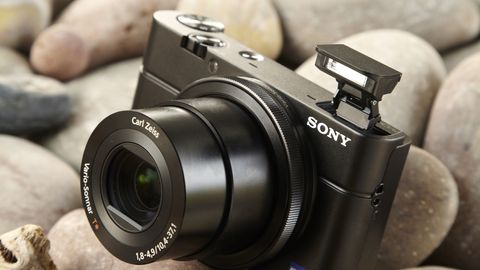Why you can trust TechRadar
With the RX100, Sony has gone for a very sleek and smooth design, with a total body size that is fantastic for the amount of power contained within.
Although it is small, it is weighty enough and feels solid enough to give it a feel of real quality. The metal chassis also feels tough enough to withstand the odd knock and scrape. To back this up is the automatic drop detection that sees the camera retract its lens to protect itself should it detect a sudden fall.
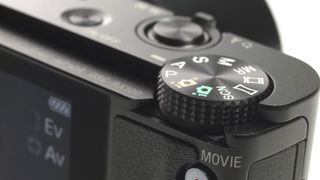
The RX100 is equipped with a 3.6x optical zoom lens. The physical size of the zoom is packed away in the camera's tiny body and feels very study when fully extended. The zoom is operated via a switch at the top of the camera. This feels solid and well made, and zooming itself is smooth and fluid
Again, although it is diminutive, Sony has made good use of space on the RX100 with a sensible button layout. The buttons themselves are well made, and give a satisfying click when pushed. Each of the buttons on the back of the camera is customisable, depending on how you prefer to shoot - or the settings you want to use most often.
Somewhat similarly styled to the Canon S100 premium compact, the RX100 also features a ring around the lens which can be used to set a number of different functions, such as aperture, depending on the shooting mode. It can also be customised to a different setting should you prefer it.
The ring is a great bonus, and is another element which adds an air of quality, as well as retro chic, to the RX100. Turning it smooth and fluid, while the clicks it makes as you rotate the dial can be switched off if you are shooting in video or just prefer a more discreet option.
One of the most useful features of the camera is the ability to add up to seven different functions to the Fn button. These can be changed to suit your needs, and you can also elect to only save a couple here to prevent lots of scrolling.
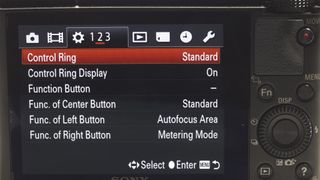
A button that does appear to be missing, is a dedicated delete button. However, the question mark button acts as a delete button when entering playback mode.
The menu system will be incredibly familiar to anyone using any of Sony's DSLT range, being almost identical. Most features are easy to find, and you can set the Menu to either start from the first page, or the previous page you were looking at - a handy feature if you're changing the same setting often.
Start-up time for the RX100 could be quicker, taking a couple of seconds to go from power off to focusing on a subject. It's possible that very quick action could be missed due to this, but it should be fine for the majority of shots.
With its fairly large size (3 inch) and high resolution (1.229k dot), the screen is one of the RX100's best features, offering a clear and bright view from a number of different viewing angles. Images appear sharp, bright and colours look fantastic from the device. Working well in outdoor conditions, it only starts to struggle to provide a clear view in the very brightest of sunlight.
Sony has equipped the screen with TruBlack technology and a RGBW (red, green, blue, white) structure, which it says is favourable for higher contrast. Using the screen in practice is very good, whether composing images or playing back those already shot.
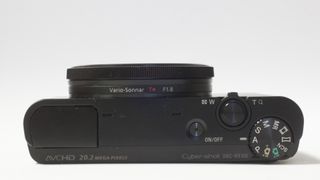
One complaint however, is that the device is not a touchscreen. That would have been extremely handy for functions such as changing the autofocus point, but Sony has said that it doesn't feel that the target user of this camera necessarily desires a touchscreen option. We're not sure we agree with this, but we can see that the company is trying to appeal to a more "traditional" kind of user.
Although other cameras in this segment (notably the Canon G12) have an articulating screen, this camera is all about keeping it sleek and simple and a flexible device would obviously add bulk. Some may feel it's a shame that there's no hotshoe, or accessory port, to add an optional electronic viewfinder, but again this would have meant sacrificing sleekness.
One of the most appealing aspects of the RX100 is its ability to shoot in raw format. However, this option is not available for all shooting modes, such as Picture Effects, Clear Zoom and Auto Portrait Framing.
It would have been nice to be able to shoot in raw format for Picture Effects, so that you could remove them later in post-production, while Clear Zoom could have given you the option to shoot at the farthest optical reach of the lens and allowing you to crop in later. Not only this, but it's also frustrating having to dive back into the main menu to switch off raw shooting then go back to the mode you were trying to use. Perhaps Sony could implement a pop-up box which says "Would you like to turn off raw shooting?" to solve this.
Speaking of the Picture Effects, which are basically digital filters, an impressive number can be found on the RX100. However, with so many to scroll through (an option that can be accessed via the Fn button), it would be nice to be able to quickly switch off any deployed art filter, rather than having to scroll through lots of others to reach the "off" setting.
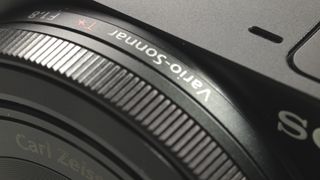
Some of the filters don't display a preview on the screen, such as Illustration, meaning it can be easy to forget you have this setting activated and accidentally leave it on when shooting something else. Since you can't shoot in raw format with this activated, you could be stuck with a less than desirable image in some cases.
A digital level can be activated by hitting the Display button a couple of times. This is extremely useful when shooting landscapes, and it's handy that it stays on screen even when half-pressing the shutter to focus.
Amy has been writing about cameras, photography and associated tech since 2009. Amy was once part of the photography testing team for Future Publishing working across TechRadar, Digital Camera, PhotoPlus, N Photo and Photography Week. For her photography, she has won awards and has been exhibited. She often partakes in unusual projects - including one intense year where she used a different camera every single day. Amy is currently the Features Editor at Amateur Photographer magazine, and in her increasingly little spare time works across a number of high-profile publications including Wired, Stuff, Digital Camera World, Expert Reviews, and just a little off-tangent, PetsRadar.
